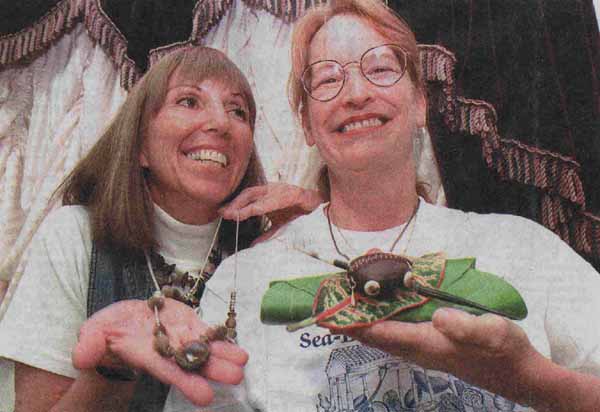1999 |
 |
|
|
 CATHIE KATZ, left, of Melbourne Beach shows off a sea bean necklace made by Pati Palazzola. Cathy Yow, right, of Texas shows off her heart locket at the Sea Bean Symposium Jewelry Contest held at the Cocoa Beach Library on Sunday [photo: Craig Rubadoux, Florida Today] |
 A VARIETY of sea bean jewelry, like these pieces designed by Michael Stewart of Melbourne, was on display at the Sea Bean Symposium on Sunday. |
By Aaron Davis, FLORIDA TODAY, Oct. 25, 1999 |
|
Call 'em what you want: good luck trinkets, beachcombers treasures, nature's time capsules, or call 'em what they are: seeds of exotic plants that drift around the world then wash ashore. Either way, you're talking about sea beans. And this weekend hundreds of them were found along local beaches as some 1,000 self-proclaimed "beanheads" descended on Cocoa Beach for he fourth-annual International Sea Bean Symposium. "We need to do this," said Cathie Katz, symposium founder. "There's no where else that you can go to learn about them like this. Here we gather experts from the fields of botany, marine biology, oceanography, and more to piece together the whole story of how these treasures end up where they do." Sea beans, as they've become known, are the seeds o trees and vines in locales as varied as Africa and South America. They were washed into the ocean, picked up by currents and carried thousands of miles. In Florida, more than 100 species of these beans have been found over the years. Thanks to Hurricanes Floyd and Irene, which churned the Atlantic off the Florida coast, one man found 42 species of beans during Saturday's Bean-A-Thon. "A lot of what I found was left over from Floyd," said Ed Perry, winner of the contest and park ranger from Sebastian Inlet State Park. |
One of the 30 contestants in the competition, Perry cannot attribute his win this year to beginner's luck. He first started collecting the beans for his mother, Helen Risler, when she owned the Sea Bean Boutique on the Cocoa Beach Pier in the late 1970s. "I'm getting better at it," Perry said of locating the beans that can look like anything from a small nut to a petrified hamburger patty. While the Bean-A-Thon has become the most popular part of the symposium with the public, the three-day gathering also brought the world's largest collection of sea beans and renowned authors and scientists to the Cocoa Beach Library. One such author was John V. Dennis, who co-wrote the only comprehensive book on sea beans more than 25 years ago: World Guide to Tropical Drift Seeds and Fruits. The book had been out of print since 1976, but because of renewed sea bean interest --- evidenced by the sea bean symposium, for example --- Krieger Publishing Co. has been reprinting it. Dennis sold all 100 copies he brought to the symposium. Katz said the symposium is strategically timed because during this period of the year the Gulf Stream is the closest to the Florida border making it easier to spot sea beans. |
In coming months, even casual beachcombers may spot the seeds, Katz said. And if you're out there looking for sea beans, keep your eyes open for the Lego toys too. That's right, Katz said and others who study the way beans and other debris float through the ocean believe this summer the Florida coast may get its first batch of plastic toys from a shipwreck that tossed more than 6 million toys into the ocean two years ago. Measuring between 1/2-inch and 2 inches, the buoyant toys were dumped near Britain in February 1997 and have been drifting ever since. "We have a big reward for the first person to spot a Lego," Katz said. "But I have a feeling that if we see one, we are going to see thousands, maybe hundreds of thousands." That's what happened in Britain in the months after the wreck. Children began collecting tiny Lego divers flippers, marine animals and other figures. While the legos may be an obvious treasure, Katz believes every object that washes ashore is valuable. "There's history in each of these objects," she said. "I'm just so glad so many people were here to see some of that. . |
Return to Top
Web Page: © All rights reserved.
Page Content: © FLORIDA TODAY, 1999; All rights reserved.